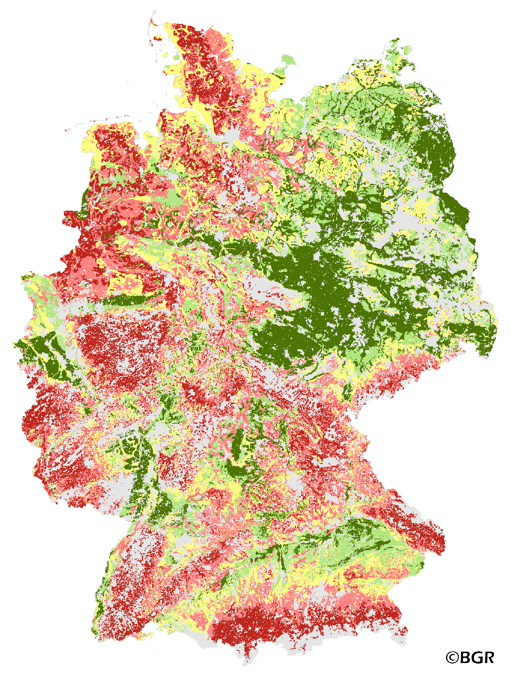Keyword
Bodenhorizont
88 record(s)
Provided by
Type of resources
Available actions
Topics
Keywords
Contact for the resource
Update frequencies
Service types
-
-
-

Web Map Service (WMS) of the BUEK1000. The first country wide soil map at a scale of 1:1,000,000 (BUEK1000) has been compiled on the basis of published soil maps of the former German Democratic Republic and the pre 1990 federal states of Germany. To do this, it was necessary to match the soil systems used in East and West Germany and to develop standardized descriptions of soil units. A relatively homogeneous map has resulted, which permits uniform assessment of the soils throughout Germany. The map shows 71 soil mapping units, described in the legend on the basis of the German and FAO soil systems. Each soil unit has been assigned a characteristic soil profile (Leitprofil) as an aid to map interpretation. For the first time the subdivision of the country into 12 soil regions has been represented on the map. This subdivision was coordinated with the state Geological Surveys. These soil regions will represent the highest hierarchic level of nation wide soil maps in future. The colours of soil units correspond to the standards of the 'Bodenkundliche Kartieranleitung' (KA 3; Guidelines for Soil Mapping). The various hues characterize differences in relief or soil humidity. The BUEK1000 was produced digitally. It is an important part of the spatial database integrated in the Soil Information System currently being established at the Federal Institute for Geosciences and Natural Resources (FISBo BGR). It can be used together with the characteristic soil profiles to derive thematic maps related to nation wide soil protection. The scale of the BUEK1000 makes it especially suitable for small scale evaluations at federal or EU level.
-

The first country wide soil map at a scale of 1:1,000,000 (BUEK1000) has been compiled on the basis of published soil maps of the former German Democratic Republic and the pre 1990 federal states of Germany. To do this, it was necessary to match the soil systems used in East and West Germany and to develop standardized descriptions of soil units. A relatively homogeneous map has resulted, which permits uniform assessment of the soils throughout Germany. The map shows 71 soil mapping units, described in the legend on the basis of the German and FAO soil systems. Each soil unit has been assigned a characteristic soil profile (Leitprofil) as an aid to map interpretation. For the first time the subdivision of the country into 12 soil regions has been represented on the map. This subdivision was coordinated with the state Geological Surveys. These soil regions will represent the highest hierarchic level of nation wide soil maps in future. The colours of soil units correspond to the standards of the 'Bodenkundliche Kartieranleitung' (KA 3; Guidelines for Soil Mapping). The various hues characterize differences in relief or soil humidity. The BUEK1000 was produced digitally. It is an important part of the spatial database integrated in the Soil Information System currently being established at the Federal Institute for Geosciences and Natural Resources (FISBo BGR). It can be used together with the characteristic soil profiles to derive thematic maps related to nation wide soil protection. The scale of the BUEK1000 makes it especially suitable for small scale evaluations at federal or EU level.
-
Fachinformationssystem Boden, Bodenprofildaten. Cardo-Anwendung Inhalt: Auswertung von Bodendaten mit Substrat- und Horizontbezug verwendete Standards: SQL-Server-DB, Bodenkundliche Kartieranleitung, 5. Auflage (KA5) Formen: Auskunftssystem
-
Beschreibung von Bodenprofilen nach der Nomenklatur der bodenkundlichen Kartieranleitung KA5. Zu den Bodenprofilen werden die Ergebnisse der chemischen und bodenphysikalischen Analytik gespeichert.
-
- Archiv umfassend untersuchter Bodenproben von bodenkundlichen Aufschlüssen - Bodenproben werden für Vergleichs- und Wiederholungsuntersuchungen aufbewahrt - Probenbank wird mit einer relationalen Datenbank verwaltet
-
- Anleitung zur Aufnahme von Bodenprofilen in der bodenkundlichen Landesaufnahme - standardisierte Beschreibung einschließlich Symbolschlüssel und Aufnahmeformular
-

The exchange frequency of water in soils describes how often water and the dissolved substances in it can be replaced in a soil layer during the annual leachate flow. Small water storage capacity means high replacement frequency. The risk of the discharge of easily detachable materials like nitrate is given at high exchange rates.
-

The exchange frequency of water in soils describes how often water and the dissolved substances in it can be replaced in a soil layer during the annual leachate flow. Small water storage capacity means high replacement frequency. The risk of the discharge of easily detachable materials like nitrate is given at high exchange rates.
 www.geodatenkatalog.de (S3L)
www.geodatenkatalog.de (S3L)